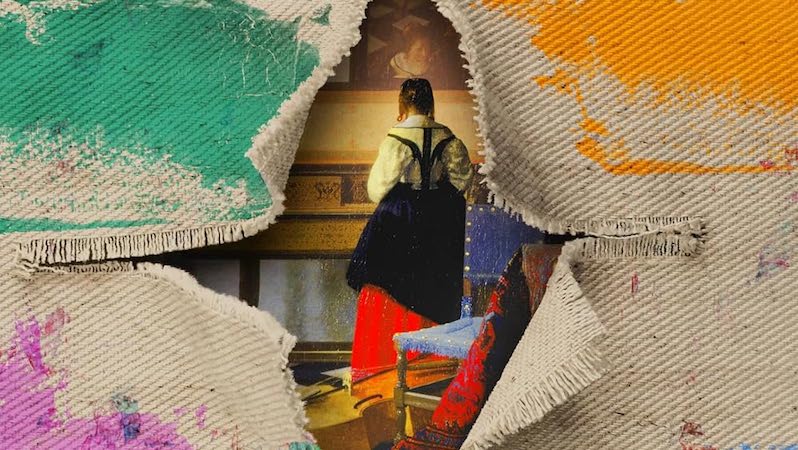What is the Writer’s Responsibility To Those Unable to Tell Their Own Stories?
On Writing About Autism, Alzheimer's, and Coma Patients
Most families have someone like me, whose interest in genealogy is inseparable from nosiness, the sort of person who just can’t resist the irreverent, pseudo-archeological curiosity for uncovering what generations before buried away for good reason. It was, I think, in no small part this desire to go spelunking through the darker passages of my family’s story that led me, one July day, to the fluorescent-bright common room of the Veterans’ Home in Concord, New Hampshire. This was nearly ten years ago now, when I was sitting there at long last with my great uncle Ralph.
In his eighties and in faltering health, the man I found was hard to reconcile with the boy I’d only seen before in our photo albums or with the mythic character I’d conjured up as my family members had told me some of their saddest stories from the middle part of the last century. Still, I held out hope that my great uncle might flesh out some of his mystery. He might, for example, tell me just what had happened to him during his military service or at least offer some better sense of what losses had transmuted him from the handsome, academically gifted boy of family lore into the shadowy older man he’d become, a fellow who spent a good part of his later years living alone and pumping gas in a remote corner of New England. And yet, by the time I met Ralph, he was already deep into the late stages of my family’s disease, the same Alzheimer’s that his father, mother, grandfather, and sister had inherited before him. Lost in the aphasia and fractured chronology of his illness, Ralph could hardly string together an entire sentence. It was plain, after five minutes or so, that Uncle Ralph’s true story would remain untold to me.
And yet, as a 26-year-old with literary aspirations, I left my first and only meeting with my great uncle in the thrall of a big idea: if Ralph couldn’t explain the traumas of his past or the dislocations of his present, then maybe I could fill in those blanks myself. I was thinking that maybe I could write a story or even a novel, based on my best guesses. I set to work right away, and I’m ashamed that it took me a few fruitless weeks of writing to ask myself the obvious question: who was I to think I had the slightest idea of what his life might have felt like? I was just beginning to understand it then, the dilemma that someone like Ralph—someone whose neurological condition precludes the ability to tell stories of his own—imposes on any potential storyteller: to let a story like Ralph’s remain in silence felt unbearably sad, and yet to intrude with my own imagination into those private, unspeakable territories felt unbearably egoistic. In the years that have followed, this particular dilemma has become lodged right in the heart of my own writing and reading.
I’m not alone in my fixation on questions like these; when encountering stories of the neurologically impaired or atypical, our most foundational assumptions about how to interpret a story’s authorship can be profoundly problematic and controversial. For example, if certain skeptics are to be believed, Japan’s second most widely read author (right behind Haruki Murakami), might not be an “author” in the way that word is commonly defined. Naoki Higashida was a severely autistic 13-year-old when he published his first memoir, The Reason I Jump, which was translated into English by novelist David Mitchell and his wife Kieko Yoshida. Though he is almost entirely nonspeaking, in The Reason I Jump Higashida writes with lyricism and astonishing sensitivity about his struggle to connect with others. “To live my life as a human being,” Higashida writes, “nothing is more important than being able to express myself.” Opening a vital window onto the internal world of nonspeaking autism, The Reason I Jump ran to the top of bestseller lists and redefined the way many readers consider the condition. In his review for The Inquisitive Mind, autism researcher and clinician William Mandy writes that Higashida “has caused me to reconsider some of the most basic ideas I have about autism.”
“Literature, built from its fundamental tools of empathy and imagination, is perhaps uniquely suited to reach into those neurological states that exist beyond language.”
But not all readers found Higashida’s accounts entirely persuasive. In a review for In-Mind magazine, psychologist Jens Hellman describes his suspicions of the “over-beauty” of Higashida’s prose and his sense that Higashida’s accounts “resemble what I would deem very close to an autistic child’s parents’ dream.” Writing for Cerebrum, high-functioning autistic author and autism advocate Temple Gradin expresses some concern over the book’s authorship: “I wish The Reason I Jump included more documentation on Naoki’s ability to communicate independently.” Though David Mitchell (on the occasion of Higashida’s recent follow-up, Fall Down 7 Times, Get Up 8) released video that shows how Higashida writes—he points to letters on a grid of Japanese characters—some doubts linger over whether the writing attributed to Higashida should be considered as entirely Higashida’s own. Given Higashida’s autism, the question of whether he might have at least in part echoed statements made by his caregivers is particularly salient; according to the American Speech-Language-Hearing Association, “Echolalia, a form of verbal imitation, is one of the most common characteristics of communication in people with autism spectrum disorder.” Furthermore, before The Reason I Jump reached an English-speaking reader, Higashida’s writing was transformed twice: after Higashida selected his words from the alphabet grid, his mother wrote down the sentences and edited the text, which Mitchell and Yoshida later translated. In his introduction to The Reason I Jump, Mitchell writes that Yoshida “did the heavy lifting” of the translation from Japanese, and that he “provided the stylistic icing on the cake.” In her review for The New York Times, Sallie Tisdale, the mother of an autistic child, wonders about that “icing,” about how Mitchell and Yoshida—who are also parents of an autistic son—might have shaped Higashida’s statements to address a non-autistic readership. “The parents of an autistic child,” Tisdale writes, “may not be the best translators for a book by an autistic child.”
For the average reader, who cannot know the interior experience of nonspeaking autism like Higashida’s or the limits of his capabilities, the question of how much of the book should be accepted as authentically generated by Higashida alone must be decided on faith. And yet, that decision could have far-reaching consequences. While autism is a condition that expresses as uniquely as each autistic person—genome scientist Stephen W. Sherer has discovered such diversity in people given the diagnosis that he argues “autisms” is a more accurate term than “autism”—the culture at large has a history of extrapolating widespread attitudes based on one particular depiction. As author Jem Lester writes in The Guardian, “ I am the father of an autistic child, and the first question I’m always asked when the subject of my son comes up is: ‘Does he have a special talent?’ because everyone has read The Curious Incident of the Dog in the Night-Time and seen Rain Man, and assume all autistic children have special powers.” Given the popularity of Higashida’s work, there is a risk that many readers will similarly receive his potentially problematic account as representative of all autistic people. If non-autistic readers receive as true, for example, Higashida’s depiction of himself as trapped in a foreign body—“as if my whole body, except for my soul, feels as if it belongs to somebody else and I have zero control over it”—then it encourages cultural attitudes that aim to release autistic people from that trap. And yet, in the view of certain commentators, this understanding of autism can be limiting; as autism advocate Jim Sinclair wrote in his groundbreaking speech Don’t Mourn for Us, “There’s no normal child hidden behind the autism. Autism is a way of being.”
Spearheaded by high-functioning autistics like Sinclair, the last few years have witnessed the rise of the neurodiversity movement, which (in the words of Steve Silberman, author of Neurotribes: The Legacy of Autism and the Future of Neurodiversity), “propose[s] that instead of viewing [autism] as an error of nature. . . society should regard it as a valuable part of humanity’s genetic legacy.” The ascent of this movement has coincided with our literary culture’s important reckoning with our history of cultural appropriation. As we draw lines around who has the right to tell which stories, it would seem that the non-autistic (or “neurotypical” in the neurodiversity movement’s parlance) world’s best response to the depiction of autism would be a hands-off approach, to stop filtering or fictionalizing autistic experiences and let autistic stories be told directly by autistic people, as in the memoirs of high-functioning autistic authors (such as Look me in the Eyes: My Life with Asperger’s by John Elder Robison). And yet, in the case of the neurologically atypical, our usual understanding of cultural appropriation can be uniquely complicated. When considering a neurological condition that is entirely non-verbal—as in the most severe forms of autism, Alzheimer’s, or locked-in syndrome—we come up against that same unique dilemma I wrestled with as I attempted to write about my great uncle Ralph: what do we do with the stories of people who are unable to tell them on their own?
Literature, built from its fundamental tools of empathy and imagination, is perhaps uniquely suited to reach into those neurological states that exist beyond language. And yet, most novels that involve a non-verbal character hew to what can be directly known. In the case of Alzheimer’s disease, for example, authors usually either track the mind of the person with Alzheimer’s only to the precipice of the late-stage, non-verbal phase (as in Debra Dean’s The Madonnas of Leningrad or Lisa Genova’s Still Alice), or else they stick to depictions of neurotypical caretakers (as in Matthew Thomas’ We are Not Ourselves). These stories can illuminate the daily realities of earlier stage Alzheimer’s and the exigencies of caregiving, but they also leave unanswered a central question that anyone facing an Alzheimer’s diagnosis (or, like myself, spending time in the company of a relative with advanced Alzheimer’s) might ask, a question that people with late-stage Alzheimer’s cannot answer for us: what does it feel like to exist without words or short-term memory? A few fiction writers have taken up that question, depicting late-stage Alzheimer’s with decidedly mixed results. In his schlocky novel The Notebook, Nicholas Sparks depicts a dangerously inaccurate version of Alzheimer’s in which love can restore lost neurological function, but in Samantha Harvey’s gorgeously written novel The Wilderness, Harvey offers a nuanced, impressionist depiction of late-stage Alzheimer’s in which both language and memory are problematized in a way that feels true to the pathology of the disease I’ve read about and witnessed in my family. And yet, even with a book as artful and persuasive as Harvey’s, readers are left with the central question: how true is it? Where does a writer’s ability to empathize with the otherness of a non-verbal condition break down and where does the writer’s projections of his or her own, neurotypical self begin?
“There are no clear answers for neurotytpical caregivers or storytellers; people who cannot communicate, by definition, will never be able to tell the neurotypical world how we should represent them.”
These questions are not merely cultural; they can have life-or-death consequences, perhaps with no higher stakes than for a Belgian man named Rom Houben. Born in 1963, Rom Houben was just in his early twenties when he got into a severe car accident, which left him in a coma. At the time, doctors diagnosed Houben as vegetative (or “minimally conscious”). Houben spent the following 17 years in a state hospital, presumed to be brain dead, until at last an enterprising doctor subjected Houben to a new brain scan technology. The doctor was stunned by his discovery: responding to stimuli and speech, Houben’s brain appeared to function almost normally. Apparently, Houben had been wrongly diagnosed. He had been awake and aware, trapped in his body and unable to speak a word, for nearly two decades. Desperate for a way at last to let Houben communicate, his caregivers began to work with a speech pathologist who employed a controversial technique called “Facilitated Communication.” Based on some faint movement the speech pathologist felt in Houben’s muscles, she made swift and astonishing progress. Guiding Houben’s fingers along a keyboard, the speech pathologist allowed Houben to speak with his family for the first time in all those years. With the speech pathologist’s help, what Houben “wrote” was remarkable: he spoke with tremendous hope and clarity of his “rebirth”; he even began to write a memoir.
But then, watching news reports of this seemingly miraculous story, a few scientists became skeptical. Facilitated Communication, they knew, has a problematic history. Initially developed to help people with non-verbal autism communicate, this technique is prone to something called the “ideomotor Effect” (aka “The Ouija Board Effect”), a phenomenon in which the speech pathologist so strongly wants to believe the patient is communicating that he or she attributes to the patient his or her own subconscious desires of what the patient might want to write. When the pathologist and Houben were put to rigorous testing, it soon became clear that it was the speech pathologist, not Houben, who had been the true author of all those words.
Houben’s story is tragic and highly uncommon, but it also reflects the ethical dilemma the neurotypical world faces when it tries to portray the internal lives of people who can’t communicate. On the one hand, as Houben’s story demonstrates, the attempt to claim to represent the mind of a non-verbal person can have disastrous consequences in terms of how others consider and treat such people; perhaps Houben was not at all “glad” to be alive, perhaps Houben (and a great many like him) wanted only to be set free. On the other hand, I’m sensitive to the desperation that Houben’s caregivers must have felt, their need to let Houben communicate so urgent that they were able not to question the way he “spoke.” As with my great uncle Ralph’s late-stage Alzheimer’s, the thought of allowing the interior experience of a nonverbal person to remain in silence also feels unbearable.
In the decade since I made the trip to Ralph’s nursing home, these questions have continued to lurk behind my own stories. My new novel, Oliver Loving, is in large part inspired by Rom Houben’s story, and for a long while I also struggled over the decision of how far I could allow myself to believe in a possibly problematic representation of a nonverbal mind. When I tried to write the story from the trapped perspective of a character like Houben, I worried that I had committed a terrible trespass, using a situation like Houben’s as a metaphor for what remains trapped and unspeakable in any one person. When I switched tactics, trying to write the novel exclusively from neurotypical perspectives, I saw I had avoided the very urgency that had first drawn me to the subject and allowed the locked-in story to remain in silence. Unable to resolve that dilemma, I settled on a compromise, making that same dilemma central to the book’s plot; like me, the family in Oliver Loving struggles with the question of whether to believe in their own imagined versions of a locked-in mind, in a situation where belief itself can have disastrous consequences. When caretaking for patients like Houben (or my fictional Oliver), patients diagnosed as minimally conscious, it is a family’s belief that some part of their loved one remains that often allows such patients to survive, but one could equally argue that belief is what imprisons total locked-in patients like Houben in a literally unspeakable hell.
In the end, of course, there are no clear answers for neurotytpical caregivers or storytellers; people who cannot communicate, by definition, will never be able to tell the neurotypical world how we should represent them. And so, as with the debate around the authenticity of The Reason I Jump or any fictional depiction of a nonverbal mind, the question remains, a moral dilemma that can only be decided on faith: knowing the dangers of false belief but knowing also that it is skepticism that allows unspoken stories to remain in silence, how far should we permit ourselves to believe?




















